
Dien Bien, situated approximately 450 kilometers from Hanoi, shares its borders with Son La and Lai Chau, and has frontiers with China and Laos. The capital city is Dien Bien Phu, which includes Muong Lay Town and eight districts.
The region experiences a tropical monsoon climate characterized by high mountains, cold winters with minimal rainfall, and hot summers with abundant precipitation, influenced by dry and warm westerlies.
The average annual temperature ranges between 21 to 23 degrees Celsius, with the lowest recorded at around 13 degrees Celsius and the highest reaching about 25 degrees Celsius.
The dry season extends from October to April of the following year, while the rainy season typically spans from May to August. The sunniest months are March-April and August-September.
Dien Bien is home to a collection of historical sites commemorating Vietnam's victory at the battle of Dien Bien Phu in 1954.
Additionally, Dien Bien features numerous caves, mineral water sources, and lakes that contribute to its natural tourism resources, such as the Muong Nhe primeval forest, and the U Va and Pa Khoang lakes.

The Pha Din Pass in spring, adorned with blossoming bauhinia flowers. Photo by VnExpress/KK
The Dien Bien Phu Battlefield Relics Complex is a key stop for exploring historical sites in Dien Bien Province. Conveniently situated close to each other, these locations allow tourists to explore them in a single visit.
Hill A1
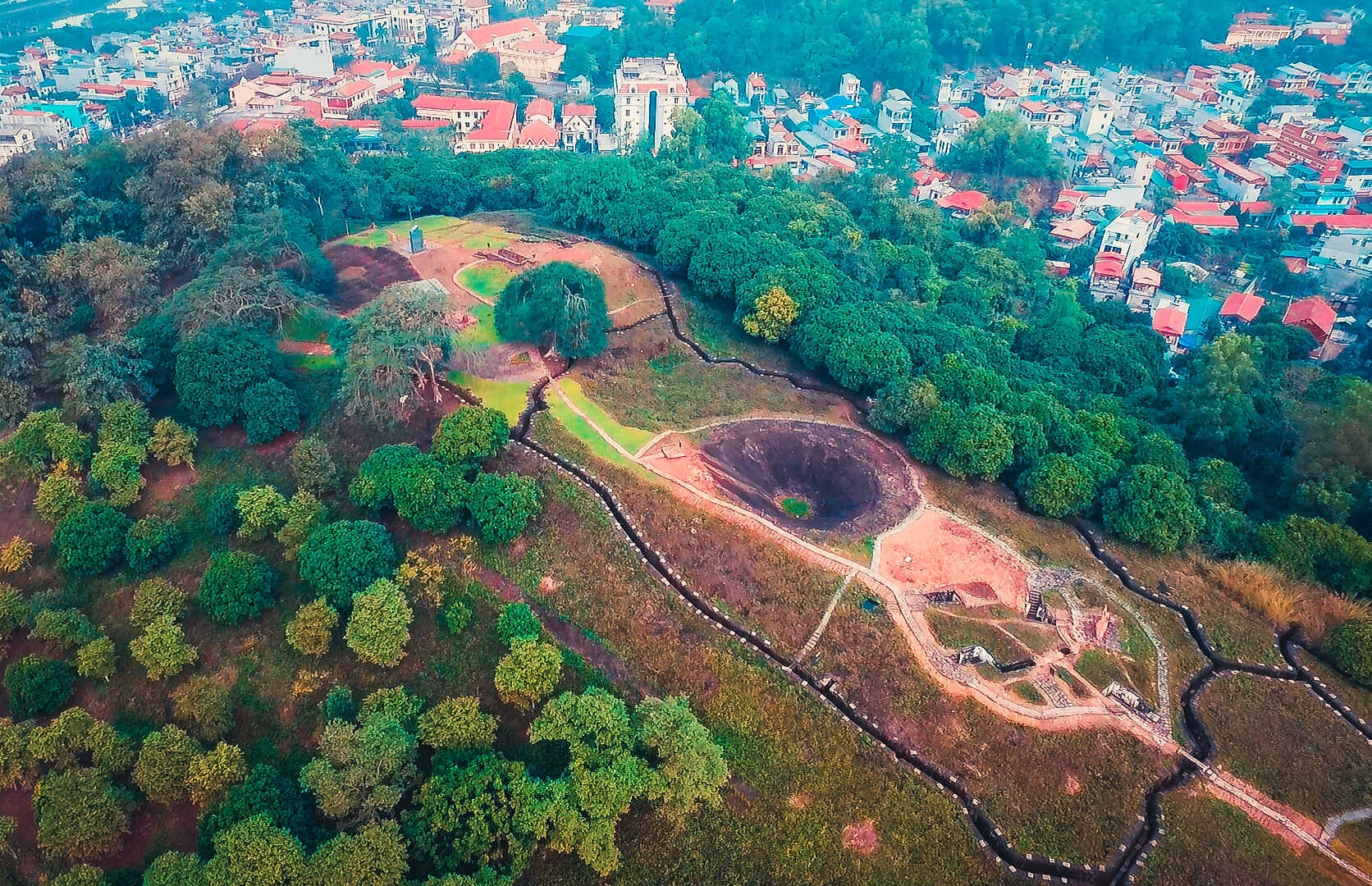
Panoramic view of A1 Hill, showcasing well-preserved remnants from the Battle of Dien Bien Phu. Photo by Thanh Nien
Situated in Muong Thanh Ward, Dien Bien Phu City, the capital of the province, A1 Hill stands as a crucial battleground of the Battle of Dien Bien Phu.
Originally known by various names, the slope was officially designated A1 Hill by the Vietnamese military. Surrounding A1, the French army built a system of barbed wire fences. At the hill's summit lies a fortified cellar, once serving as the French legation's wine cellar before 1945.
The cellar, divided into two compartments, one of them housed the radio information department. Constructed with solid brick walls and a thick concrete roof, the tunnel could shelter dozens of people. A1 Hill still bears witness to a blast hole created by 960 kilograms of explosives.
Today, visitors to A1 Hill can not only enjoy sightseeing but also partake in hands-on activities. These include cooking soldiers' rice using Hoang Cam stove, a stove intake and chimney system designed to disperse and dissipate cooking smoke. Visitors can also partake in activities such as assisting with bicycle transport for necessities, and hearing stories about the Dien Bien Phu campaign and the soldiers' lives in combat.
General (Christian Marie Ferdinand de la Croix) de Castries's bunker
General de Castries's bunker was built by the French colonialists in the center of the Dien Bien Phu Fortress. The bunker, recognized as "the most solid tunnel in Indochina," is positioned approximately 1 kilometer from Hill A1. The surrounding area is protected by a defensive fence featuring a barbed wire system and four tanks.
Currently, the structure and arrangement of the bunker are well-preserved for visitors to explore. The tunnel itself is 20 meters long and 8 meters wide, containing four rooms that served as both living and working quarters for General de Castries and his soldiers.
Dien Bien Phu Museum
Located in Muong Thanh Ward, the Dien Bien Phu Museum, inaugurated on May 5, 2014, following 19 months of construction, stands as a monumental achievement of historical, cultural, and artistic significance.
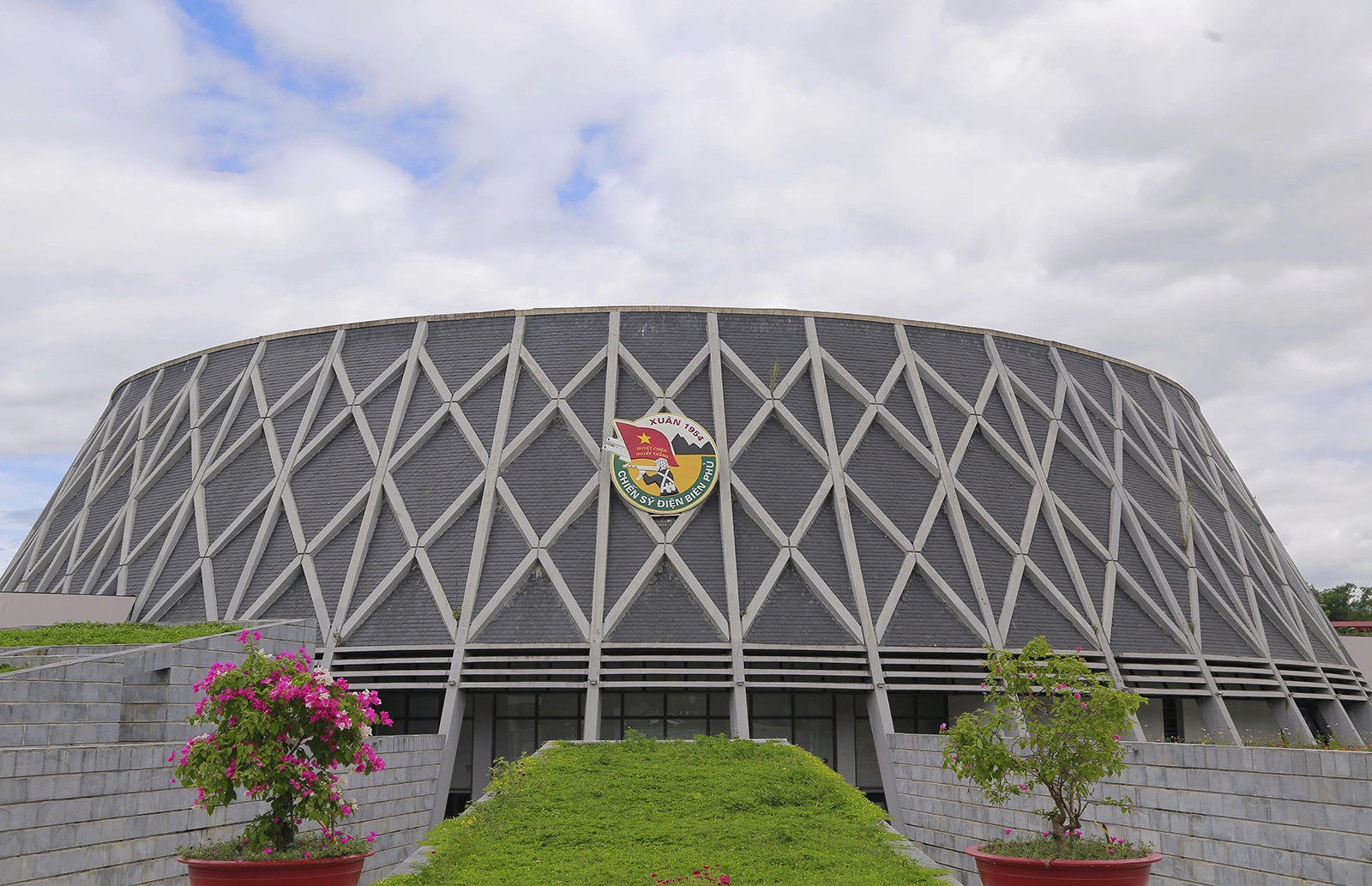
The Dien Bien Phu Museum’s crossed-diamond design recalls the camouflage net on army helmets. Photo by VnExpress/Van Dat
Built with an outer facade of decorative elements that resemble diamonds, the design symbolizes the camouflage net of army helmets. The museum comprises a basement and an upper floor.
The basement serves as a welcoming space for visitors, providing an environment for learning, interaction, and entertainment services. Meanwhile, the upper floor is dedicated to thematic exhibitions centered around the victory of Dien Bien Phu, featuring an area of 1,250 m2 displaying nearly 1,000 documents, artifacts, images, and maps.
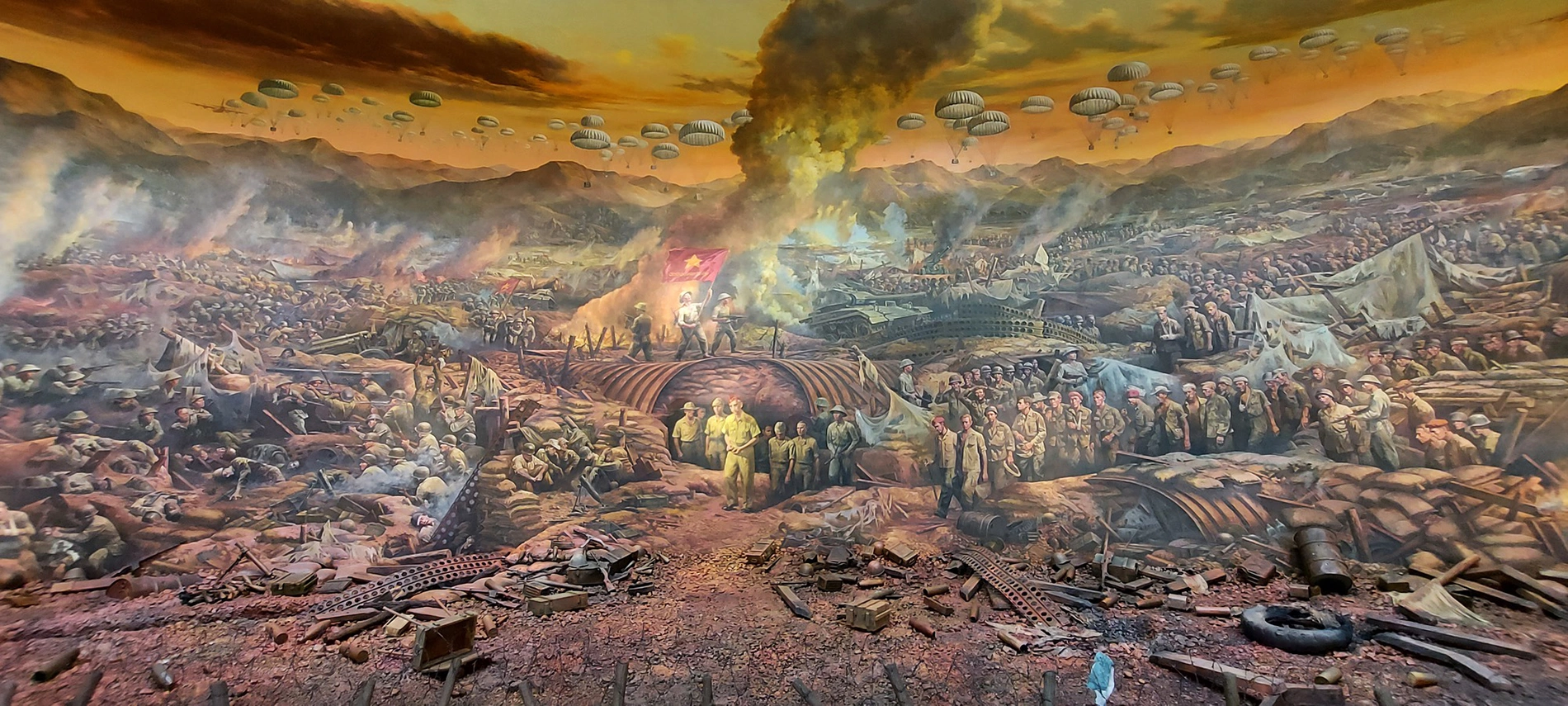
A section of the panorama painting depicting the Dien Bien Phu battle at the museum. Photo by VnExpress
A notable highlight is the panoramic painting, boasting over 4,500 characters. This artwork is 132 meters long, 20.5 meters high, with a 42-meter diameter, covering a total area of more than 3,200 m2. Executed in oil on canvas, the painting was started in November 2019 and was completed on May 1, 2021, with the collaboration of approximately 100 artists. It portrays the stages of the 1954 Dien Bien Phu Campaign.
Dien Bien Phu Victory Monument

The monument shows three soldiers standing together, holding a Thai child, and topped with a victory flag. Photo by VnExpress/Van Dat
Inaugurated on May 7, 2004, marking the 50th anniversary of the Dien Bien Phu Victory, the monument stands on Hill D1 in the city center. This collection of monuments represents the tallest, largest, and heaviest assembly of bronze statues in Vietnam to date. The main statue stands at a height of 12.6 meters and was crafted using 217 tons of bronze.
A1 National Martyrs Cemetery
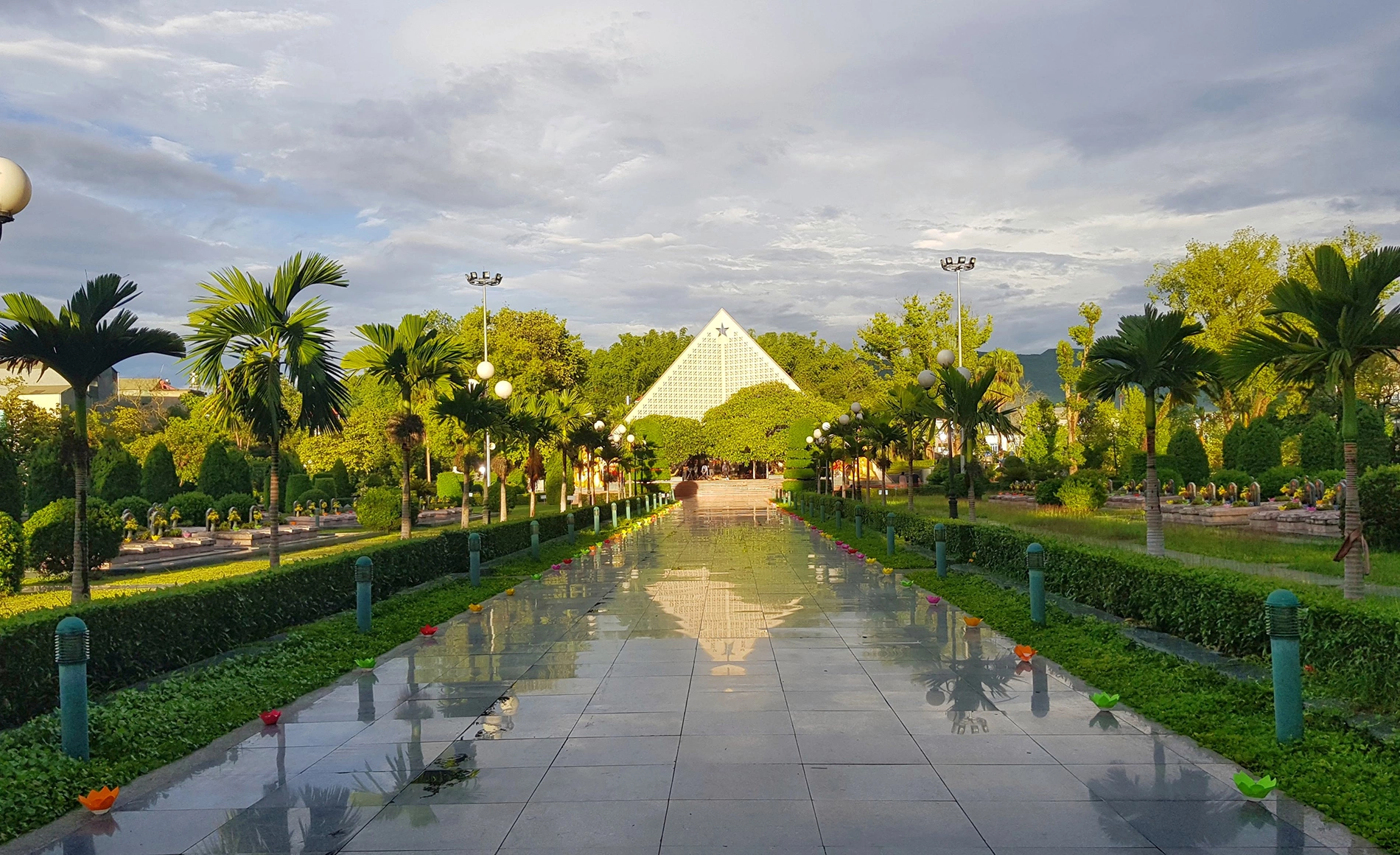
The pathway to the cemetery is adorned with glass tiles and bordered by green trees on both sides. Photo by VnExpress/Van Dat
Situated on Vo Nguyen Giap Street, just a few hundred meters from A1 Hill, this cemetery serves as the final resting place for 644 officers and soldiers who lost their lives in the Dien Bien Phu Campaign. The majority of the site is occupied by unmarked graves. The main building features the stilt house architecture of the Thai people in Dien Bien, while the exterior ceremonial platform is designed in accordance with Khue Van Cac, an architectural feature of the Temple of Literature in Hanoi.
Campaign headquarters in Muong Phang Commune
The Dien Bien Phu Campaign headquarters relic in Muong Phang Commune is situated over 1,000 meters above sea level, nestled at the base of Pu Don Mountain and concealed within the forest canopy, more than 30 kilometers from the center of Dien Bien Phu City.
The Command Post's structures are arranged in a continuous system, enveloped front and back, incorporating bunks and camps for secrecy and safety. This location served as the working and resting place for General Vo Nguyen Giap during the campaign.
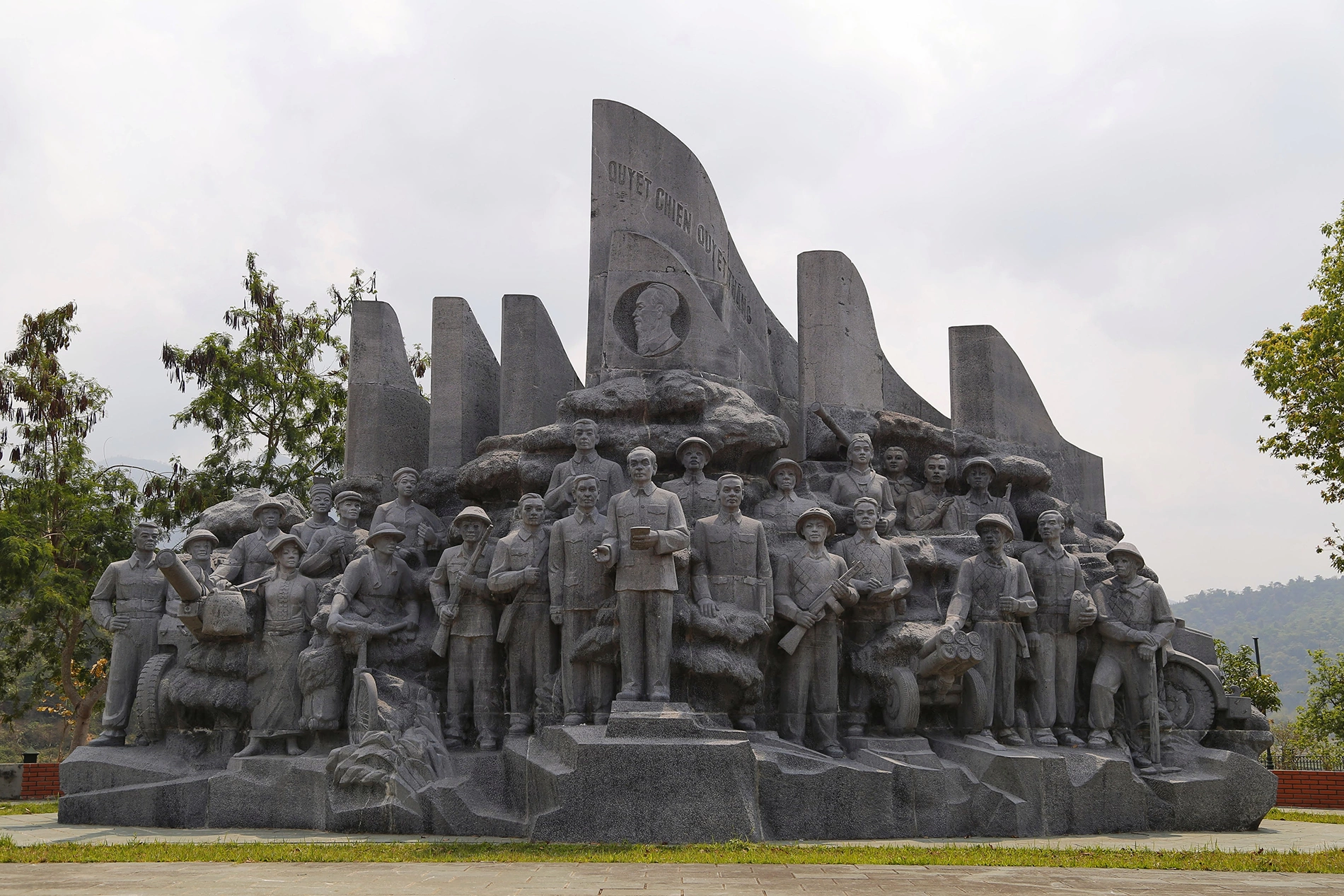
The Muong Phang Victory Monument cluster features 25 figures, each with an average height of 2.7 meters, representing the forces involved in the Dien Bien Phu Campaign. Photo by VnExpress/Van Dat
From the highest vantage point, visitors can enjoy a panoramic view of Dien Bien Phu City, Muong Thanh Valley, and French army bases such as Him Lam Hill, Doc Lap Hill, D1 Hill, C1 Hill, and A1 Hill. The Victory Monument cluster at Muong Phang Park is a recommended stop for visitors.
Additionally, Muong Phang boasts a cherry garden that blooms during spring, situated on an island in the middle of Pa Khoang lake.
Pha Din Pass
Stretching 32 kilometers along National Highway 6, Pha Din Pass serves as the gateway to Dien Bien Province. The pass reaches an elevation of 1,648 meters above sea level, with one side featuring a cliff and the other an abyss. This location marks the beginning of the journey undertaken by Vietnamese soldiers and civilians during the Dien Bien Phu Campaign, involving the manual transportation of artillery, food, weapons, and ammunition.

A stopover on Pha Din Pass offers visitors a panoramic view of the pass. Photo by VnExpress/Thieu Hoa
Pha Din Pass, now safer with wider roads, features winding paths and a tourist area for resting and enjoying the scenery. It also facilitates exchanges between people from Dien Bien and Son La Provinces.
Muong Thanh Field and Nam Rom River
In Dien Bien's heart, Muong Thanh Field is like a large "storehouse" filled with corn and rice. By late September, the rice in the Muong Thanh basin starts ripening.
The field is more than 20 kilometers long and about 6 kilometers wide, situated over 400 meters above sea level. When seen from above, it looks like flower petals along the Nam Rom River, surrounding the historical sites of the Dien Bien Phu Battle.
Muong Nhe District
Muong Nhe, situated in the northwest of the province, hosts the westernmost point of Vietnam at the Vietnam-Laos-China border junction, approximately 250 kilometers from the center of Dien Bien Phu City.
The region is covered by forests, constituting 55% of its total area. Additionally, Muong Nhe is home to the Muong Nhe Nature Reserve, one of Vietnam's largest special-use forests, featuring a diverse ecosystem.
A Pa Chai, located in Muong Nhe, is renowned as the most prominent destination. It houses the milestone zero coordinate atop Khoan La San Mountain, installed by the three countries on June 27, 2005. Crafted from granite, each side of the milestone is engraved with the respective country's name and national emblem. Market days at A Pa Chai, occurring on the 3rd, 13th, and 23rd of every month, highlight the cultural richness of the border region.
The journey to A Pa Chai is relatively straightforward during the dry season but can become challenging and even hazardous in the rainy season. It is advisable for visitors to have a guide to ensure safety.
Muong Lay Town
Muong Lay Town, known as the capital of the White Thai people, lets visitors take a boat ride on the Da River to enjoy nature and learn about Thai culture. A must-visit in Muong Lay is the Hang Tom Bridge, connecting Dien Bien and Lai Chau provinces.
The original Hang Tom Bridge, constructed in 1967, once held the distinction of being the largest cable-stayed bridge in Indochina. However, in November 2012, the Son La hydroelectric dam overflowed, submerging the entire old Muong Lay Town, along with the Hang Tom Bridge, which was then beneath the waters of the Da River.
In the vicinity of the former Hang Tom bridge site, a new bridge has been constructed, positioned 70 meters higher than its predecessor.
Dien Bien Dong District
Situated in the southeast of Dien Bien Province, Dien Bien Dong is a district characterized by towering peaks, making it an ideal destination for trekking adventures.
The Chop Ly Peak, located 35 kilometers from Dien Bien Phu City, offers a view of mountain scenery with clouds. The best time for cloud hunting is from April to September.
Dien Bien Dong also features Noong U Lake, a natural lake in a green mountain setting, covering about 4 hectares, attracting visitors for its beautiful scenery.
Additionally, neighboring districts like Muong Cha, Muong Ang, Nam Po, Tua Chua have ecotourism areas and destinations suitable for tourism, such as trekking mountains or learning about the lives of indigenous tribes.
U Va Hot Spring
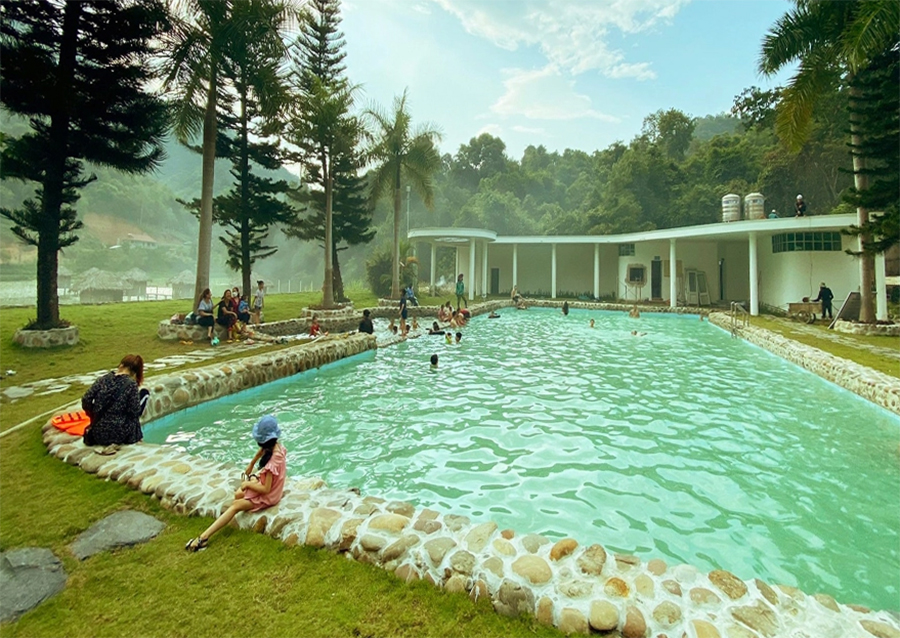
Hot mineral baths at U Va. Photo courtesy of Dulichpro
Located around 15 kilometers from Dien Bien Phu City in Dien Bien District, U Va Hot Spring covers an area of 73,000 m2. The best time to visit is from November to April when it’s cooler. The hot mineral spring offers various services for relaxation.
If you want to soak in hot minerals, it’s best in the early morning or afternoon. Afterward, you can partake in other activities like tennis, cycling, badminton, as well as enjoy traditional music performances from the Dao and Hmong ethnic groups.
Entrance tickets range from VND20,000 to VND120,000 (US$0.80-4.90) per person, and stilt house accommodations range from VND120,000 to VND220,000 per room.
Ban Phu Citadel
Ban Phu Citadel (also known as Chieng Le Citadel) in Dien Bien District, 8 kilometers south of Dien Bien Phu City center, was built 200 years ago. The citadel was built by Hoang Cong Chat (1706-1769), who led local people against village tyrants, robbers, and northern invaders.
Despite damage from past invasions, the citadel retains historical, cultural, and scientific value. In 1981, it was designated a national historical and cultural relic by the Ministry of Culture, Sports and Tourism.
Grilled chicken with mac khen
Mac khen, a common spice in the northwest mountains, gives a distinct flavor to the grilled chicken here compared to similar dishes in other places. It imparts a citrusy and slightly numbing sensation to the palate, similar to Sichuan peppercorns.
Pa pinh top
This specialty from Dien Bien is essentially grilled fish, particularly various carp varieties. After cleaning, the fish is sliced along the spine. Spices, such as ginger, lemongrass, herbs, mac khen, and buds of the sa nhan - wurfbainia villosa plant, are marinated and stuffed into the fish's belly. The outer part is seasoned with galangal powder and toasted rice powder before being grilled over charcoal. To intensify the flavor, a bamboo stick is employed to secure the fish, allowing the spices to infuse deeply, resulting in a fragrant and sweet meat.
Braised duck with banana blossoms
After cleaning, the duck meat is marinated with spices like chili, ginger, lemongrass, and mac khen. It's then wrapped in banana leaves along with sliced banana blossoms and braised for about 3 hours over low heat until cooked.
Dien Bien locals prefer using wild banana blossoms with long stems for better taste, sweetness, and a milder flavor. Despite its simple look, the dish releases a sweet aroma when the banana leaf layer is opened.
Ground pork steamed in banana leaves
As the name suggests, this dish is made from ground pork marinated with spices and wrapped in banana leaves. It's then steamed for about an hour until fully cooked. The key to its deliciousness lies in using fresh meat. Although uncomplicated, the dish leaves a lasting impression with the combined aromas of meat and banana leaves. The result is soft, fatty meat that sticks together.
River moss
River moss naturally grows on rocks submerged in the river seasonally from the ninth to the tenth month until the end of the next fifth month of the lunar calendar. It is not cultivated but grows naturally.
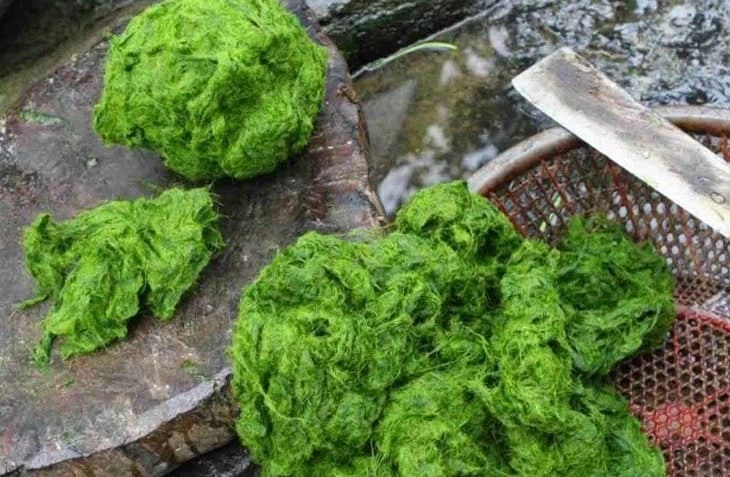
River moss has a vibrant green color. Photo by VnExpress
During moss season, Thai people collect young moss for dishes like steamed moss, moss soup, or moss salad. The most savory rendition involves wrapping the moss in banana leaves or dong (phrynium placentarium) leaves and grilling it over charcoal. River moss also pairs well with grilled fish, pork, and chicken.
Cham cheo seasoning
Cham cheo is a traditional spice of the Thai people in Dien Bien region and the northwest region in general. The main ingredient is mac khen fruit, accompanied by anchovies, salt, hat doi - magnolia seeds, garlic, water mint, chili powder, lemongrass, among others.
After cleaning, mac khen is roasted until crispy, then crushed and mixed with dried chili, lemongrass, salt, and herbs to create a blend of flavors. Cham cheo adds a burst of flavor when paired with sticky rice, boiled or grilled dishes.
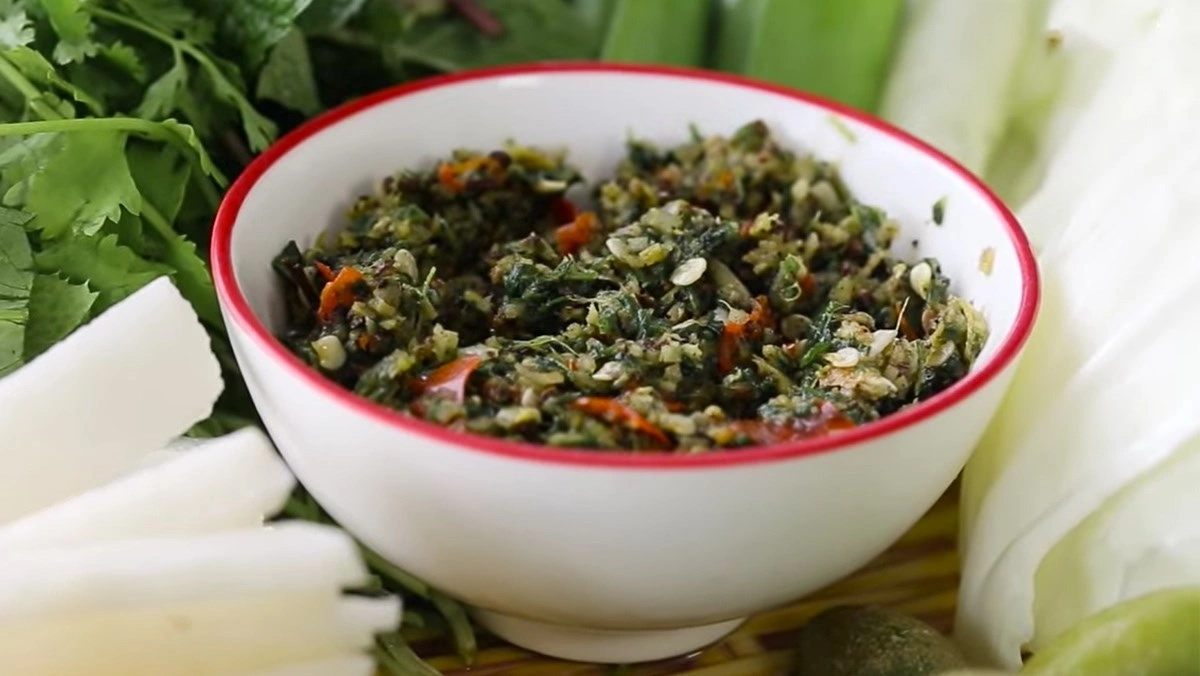
Following a period of closure for renovations, Dien Bien Airport reopened its doors to passengers on Dec. 2, 2023. Vietnam Airlines offers direct flights from Hanoi every day of the week, with round-trip ticket prices ranging from VND1.6 million to VND2.8 million ($65 to $115).

Dien Bien Airport is upgraded and open for flights with a larger path. Photo by Thanh Nien
Travelers from Ho Chi Minh City can also fly with Vietnam Airlines, with a layover in Hanoi. Vietjet provides direct flights from Ho Chi Minh City, operating three times a week on Tuesdays, Thursdays, and Saturdays, with a round-trip ticket price of approximately VND2 million ($82).
The road from Hanoi to Dien Bien Phu City spans 450 kilometers. Tourists can choose between two routes: CT08, CT02, QL6 through Hoa Binh Province or DT87, QL32, QL37 through the provinces of Hoa Binh and Son La. The travel time is approximately 10 hours.
Passenger buses serving the Hanoi - Dien Bien route are operated by several companies, including Nam Lien, Nam Oanh, Hai Van, Khanh Le, Cuong Tam, and Chien Ha. Ticket prices range from VND300,000 to VND350,000 ($12 to $14), and buses depart from My Dinh Station.
To reach Dien Bien Phu City, travelers must traverse the iconic Pha Din Pass, one of Vietnam's four great passes, situated on the border between Son La and Dien Bien provinces. The pass spans 32 km.
It's advisable to not travel to Dien Bien during the rainy season due to the heightened risk of landslides. Since taxis are relatively expensive, consider using motorcycles or motorbike taxis as alternatives.
Accommodation options in Dien Bien are primarily concentrated in Dien Bien Phu City, offering a variety of room types, including motels, homestays, and 3-4 star hotels.
Notable hotels like Muong Thanh Dien Bien Hotel, Him Lam Hotel, Dien Bien - Hai Van, Phuong Nam, and An Loc have room rates ranging from VND700,000 to VND 1.2 million ($28 to $49) per night.
For budget-conscious travelers, motels in the city charge between VND150,000 and VND300,000 ($6 to $12) per night. Some recommended homestays, as suggested by the Tourism Promotion Information Center of Dien Bien Province, include Muong Then, Phuong Duc, Dien Bien - Rose Valley, and Nang Ban.
Story by Tam Anh